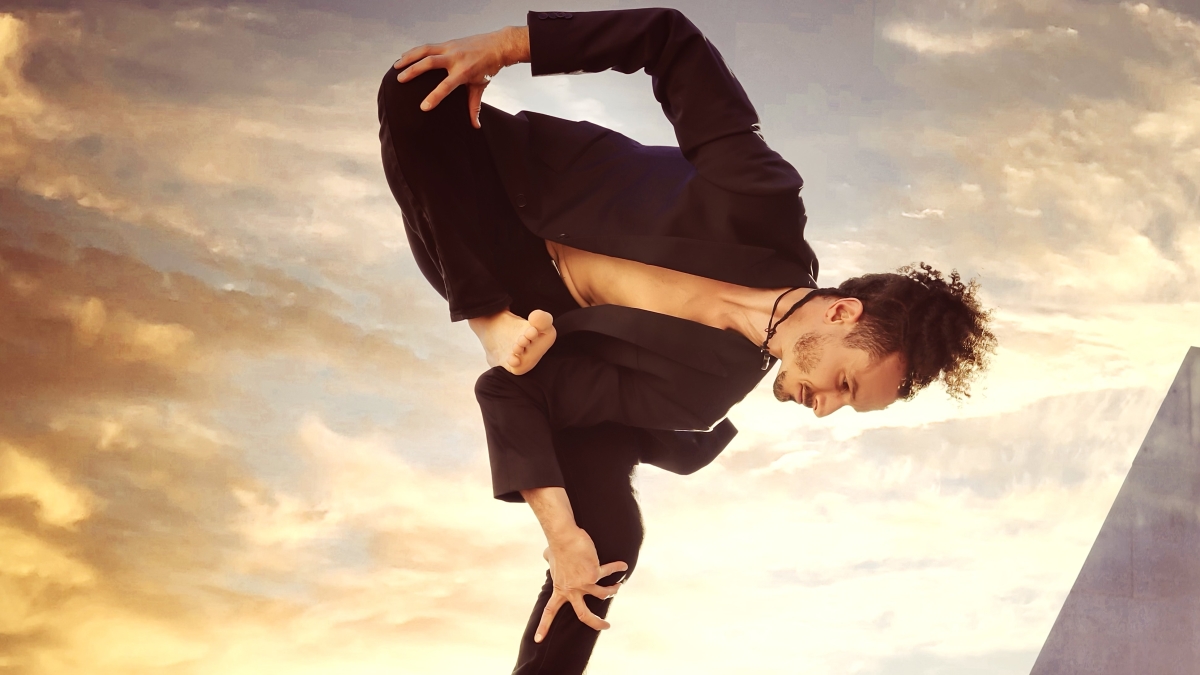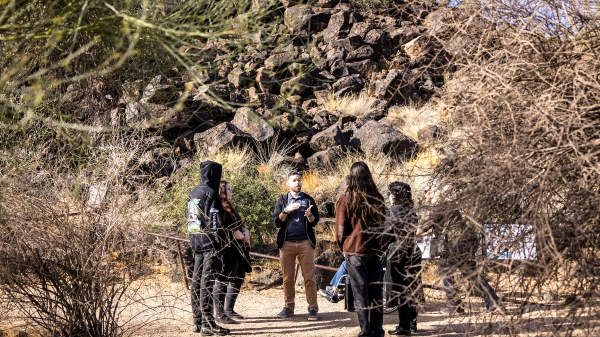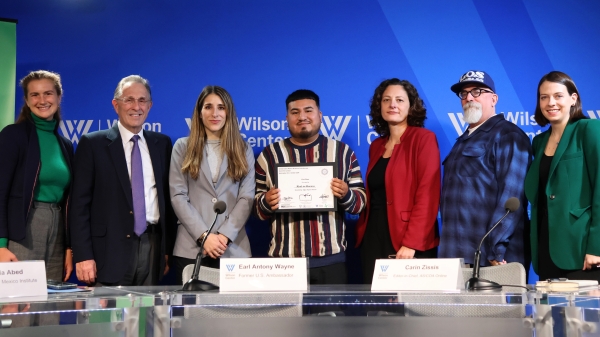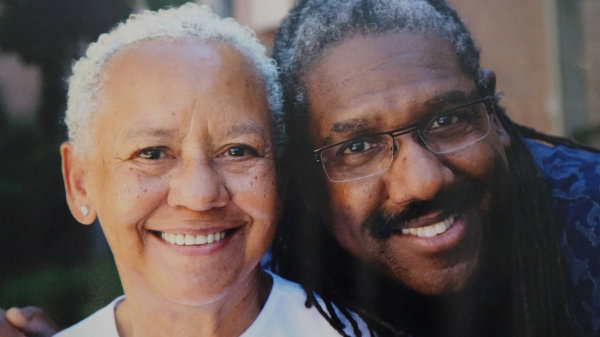MFA grad builds community, develops new technique during time at ASU

Dance MFA student Angelo “Vo Vera” Sapienza does a standing balance outside the Nelson Fine Arts Center. Photo by Courtney Skye
Editor’s note: This story is part of a series of profiles of notable fall 2023 graduates.
Angelo “Vo Vera” Sapienza wanted to attend graduate school 10 years ago. He applied and got into the master’s program in dance at Arizona State University, but the timing wasn’t quite right. In the meantime, he spent time with his community of artists, performing and competing. Along with other artists, he founded a street arts collective called the Sacred G’s. Vo Vera also developed a street dance technique called “framing” that is inspired by street dance and club dances.
“(Framing) could have been swept into the contemporary world, but I wanted it to be a package of a toolbox for my community of practice,” Vo Vera said. “It’s essentially an 11-tool tracing system. It involves particular hand shapes and an expansive grid system that relies on the space and the artist’s view on the space.”
It wasn’t until 2021 that the timing — and financing — for pursuing further education came together. Vo Vera was recovering from a motorcycle accident and knew he wanted to keep developing his creativity. He felt it was the right time to pursue an MFA in dance from ASU.
“I knew I wanted to invest in my mind, in my ability, in my pedagogy, in my artistry, in my choreography, and I didn't realize it at the time, but my ability to think and teach and theorize,” Vo Vera said. “There were a lot of holes in my own professionality, and I knew that this path would fill those holes. I feel like it did fill every single one in every aspect.”
Vo Vera is graduating in December from the School of Music, Dance and Theatre in the Herberger Institute for Design and the Arts. During his time at Arizona State University, he, along with his street arts collective, has received more than 20 grants, including funding he received as a student. These arts and culture, academic and event grants helped Vo Vera develop at least seven community events.
“It was really special to bring communities together,” he said. “The mentorship that I received at ASU really helped drive it all home. It helped me be efficient and to be in alignment with what the grants were looking for.”
The financing Vo Vera received included the Hope and Robert Heimann Grant, the Eileen Paul Dance Scholarship, the Daniel Nagrin Dance Fellowship, the Entertainment Community Fund - Alex Dubé Scholarship, a University Grant, a University Graduate Fellowship and a University Grant: Herberger Institute for Design and the Arts Program Fee. He also received the Design and Arts Corps Grant and the Herberger Institute Creative Constellation Grant for events.
“I didn’t have to pay for most of my program,” he said. “They've got a system now that really supports the grad student.”
Question: Why did you decide to pursue dance?
Answer: I feel that dance is the ultimate physical embodiment of the human experience in creative form. It is the ultimate expression of the artist kinesthetically. My relationship to dance is on par with my relationship to life. I am very experimental, and I thrive on working through whatever is different and not the straightforward path. In being an experimentalist in how I navigate life and find joy in the unknown — which oftentimes people can find very scary — it leaves room for a lot of potential and opportunity and guidance by instinct. This nature led me to want to pursue dance experimentally. While I ended up learning the foundations of breaking and hip-hop, my artistry loves to live inside of the unknown, and also the spaces that haven’t been explored.
Q: What’s something you learned while at ASU — in the classroom or otherwise — that surprised you or changed your perspective?
A: There is really incredible mentorship at ASU. As a street dancer, I didn’t have to step outside of my zone, not once. It feels really amazing that they are trying to support the dancer for the zone that they're in, the community that they're in, and where they want to go. That overarching sense of mentorship has been really powerful.
In terms of being experimental, some people thrive on choreography; I thrive on experimenting on what is not common. It’s freestyle but taking it a step further, taking the foundations of what we’ve learned and working past those boxes and stepping into unknown territory creatively, kinesthetically, even semantically and especially philosophically or theoretically.
Somatic movement inquiry allowed us to approach experimentation from a somatic perspective. Creative movement practices allowed us to approach experimentation kinesthetically and conceptually. Ultimately, that would help me form my theory of framing. I would say that most importantly, the faculty know how to get the students to ask questions, find our values, determine what we know, what we want to know and navigate between those and create a blueprint of where we are going — even though we won’t necessarily know where we are going to end up.
Q: How did ASU faculty support and inspire you?
A: They are all really special and unique. I had the privilege and honor to work with retired professor John Mitchell. He helped me understand how I can use technology in performance. It wasn’t something I pursued, but I’ve done a lot of work creating multimedia frameworks to explore where I pair light technology with projection mapping with movement in a performative, interactive setting.
(Jorge) "House" Magana was pivotal in supporting me in all my professional endeavors — obtaining grants, producing events, recording and having an academic component to them so that I could receive credit and fulfill these grants and also honor the community. He really supported me in doing it right and not faltering.
Becky Dyer really helped me understand somatics and that framing had a somatic component. Liz Lerman opened up my mind to her creative toolbox, and I could not get enough. It was incredible to work along with her. I highly recommend her class for anybody who wants to open up and unlock their creative potential.
Q: What’s the best piece of advice you’d give to those still in school?
A: Know what you want to do and have that guide you in where you want to go. If you don’t know what you want to do, spend time with yourself and put yourself in new places to learn and help you understand what you want to do and therefore where you want to go. It is an incredibly special time for you, and if you do not take it seriously, the time glass will run out of sand, and the opportunities you could have obtained and the directions you could have pursued will fade.
Q: What was your favorite spot on campus, whether for studying, meeting friends or just thinking about life?
A: FAC 122 is my favorite, for its unique architecture and beautiful, big, open space that I spent many semesters working within and creating inside of.
Q: What are your plans after graduation?
A: I’m working on my physical health, and I’m excited to keep the ball rolling. I have opportunities to stay as an adjunct at ASU. I have an opportunity to dance with a contemporary company in Los Angeles. I have a lot of unlocked potential to share with framing. I think I’m going to share it with my local community of practice first, and see if it expands into an Arizona-based dance style.
Q: If you could focus on solving one problem in our world, what would it be?
A: I’ve been contemplating this dynamic between colonization and Indigeneity. I feel that a lot of problems can and will be solved when the values of society begin to adopt the values of Indigeneity or return to Indigeneity, working with and honoring the Earth and the land. Not just acknowledging them verbally but looking inside ourselves for how we are expressing, identifying and acting through this lens of colonization. One way I’ve been moving toward this idea of Indigeneity is by having a Native community leader speak at most of my events as a keynote speaker or performer. In that respect, he’s been sharing his knowledge in a setting where people are open to listening and ultimately assimilating that knowledge and practice. Creating the platforms for how I want to have the world change is something that I’m interested in continuing to explore.
More Arts, humanities and education

Petroglyph preserve celebrates 30th anniversary with ancient, modern tales
The Deer Valley Petroglyph Preserve provides a beautiful walk through a pristine desert where chuckwalla lizards are as plentiful…

Kaleidoscope short film contest inspires powerful binational filmmaking in its second year
“We come to this country not to steal anybody’s jobs but to take advantage of the opportunities that the rest ignore. We’ve been…

ASU's Neal Lester reflects on life, death of poet Nikki Giovanni
When Neal Lester heard on Monday that poet and activist Nikki Giovanni had died, the news hit hard.Lester, the founding director…